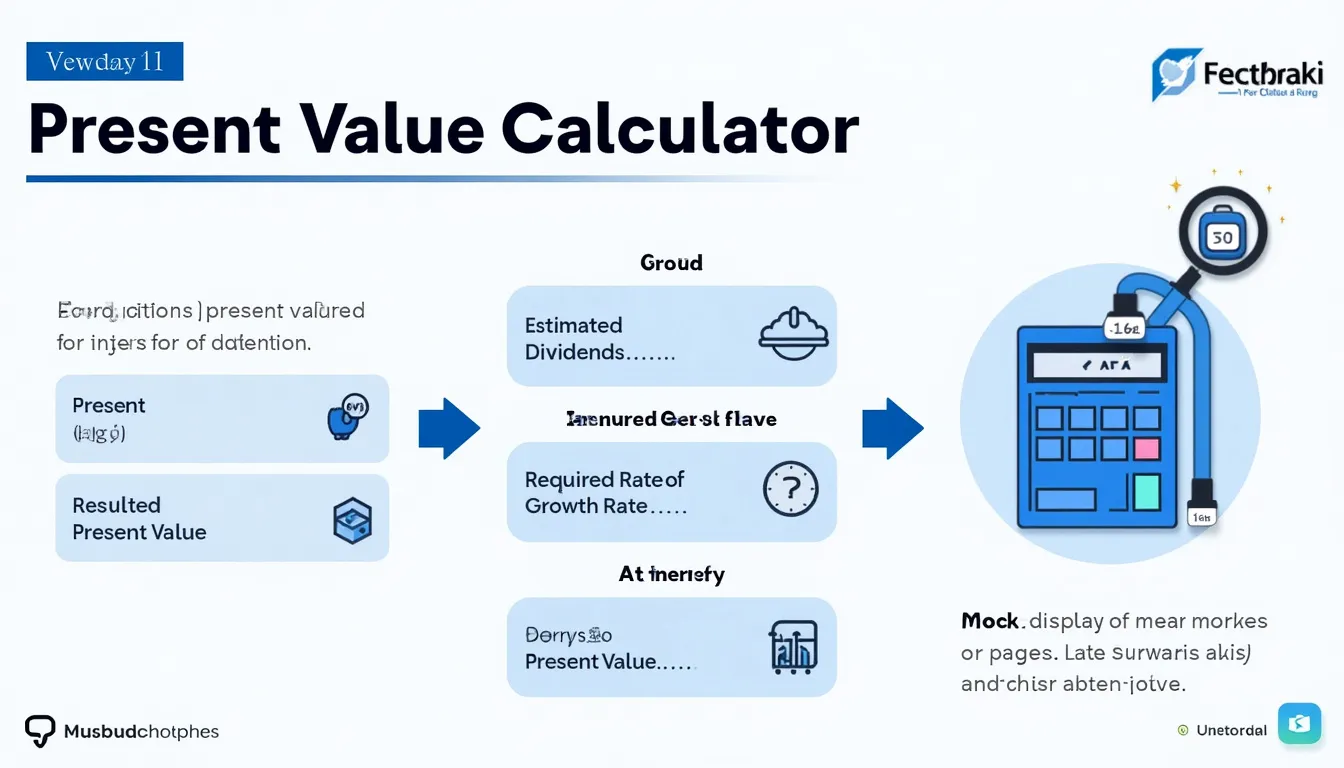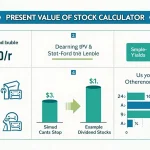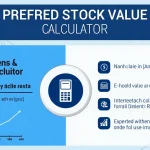Present Value of Stock Calculator
Is this tool helpful?
Welcome to our comprehensive guide on the Present Value of Stock Calculator with Constant Growth. This powerful tool is designed to help investors, financial analysts, and students accurately determine the intrinsic value of a stock based on its expected future dividends and growth rate. By leveraging the constant growth dividend discount model, our calculator provides valuable insights into stock valuation, enabling you to make more informed investment decisions.
How to Use the Present Value of Stock Calculator Effectively
Our user-friendly calculator is designed to simplify the process of determining a stock’s present value. Follow these steps to get the most out of this tool:
- Enter the Estimated Dividends for Next Period: Input the expected dividend amount for the upcoming period in dollars.
- Specify the Required Rate of Return: Enter your desired rate of return as a percentage.
- Input the Growth Rate: Provide the expected dividend growth rate as a percentage.
- Calculate: Click the “Calculate” button to obtain the present value of the stock.
- Review Results: The calculator will display the estimated present value of the stock based on your inputs.
It’s important to note that the calculator automatically saves your inputs using local storage, allowing you to easily revisit and adjust your calculations.
Understanding the Present Value of Stock with Constant Growth
The present value of a stock with constant growth is a fundamental concept in finance that helps investors determine the fair value of a company’s shares. This valuation method assumes that a company’s dividends will grow at a constant rate indefinitely. The formula used in our calculator is based on the Gordon Growth Model, also known as the Dividend Discount Model (DDM).
The Mathematical Formula
The formula for calculating the present value of a stock with constant growth is:
$$ P_0 = \frac{D_1}{r – g} $$Where:
- P₀ = Present value of the stock
- D₁ = Expected dividend per share for the next period
- r = Required rate of return (or discount rate)
- g = Constant growth rate of dividends
This formula assumes that the growth rate (g) is less than the required rate of return (r). If this condition is not met, the formula would result in a negative or undefined value, which is not meaningful in the context of stock valuation.
Benefits of Using the Present Value of Stock Calculator
Our Present Value of Stock Calculator offers numerous advantages for investors and financial professionals:
- Accurate Valuation: Obtain a precise estimate of a stock’s intrinsic value based on expected future dividends and growth.
- Time-Saving: Quickly perform complex calculations without the need for manual computations or spreadsheets.
- Scenario Analysis: Easily adjust inputs to explore different growth rates and required returns, facilitating comprehensive scenario planning.
- Investment Decision Support: Compare the calculated present value with the current market price to identify potentially undervalued or overvalued stocks.
- Educational Tool: Enhance understanding of stock valuation principles for students and novice investors.
- Consistency: Ensure consistent valuation methodology across multiple stocks or analysis periods.
- Risk Assessment: Evaluate the impact of different growth rates and required returns on stock valuation, aiding in risk management.
Addressing User Needs and Solving Specific Problems
Our Present Value of Stock Calculator addresses several key challenges faced by investors and financial analysts:
1. Simplifying Complex Calculations
Stock valuation often involves complex mathematical formulas that can be time-consuming and prone to errors when calculated manually. Our calculator automates this process, ensuring accuracy and saving valuable time.
2. Facilitating Comparative Analysis
By quickly generating present values for different stocks or scenarios, users can easily compare investment opportunities and make more informed decisions.
3. Enhancing Investment Strategy
The calculator helps investors determine whether a stock is potentially undervalued or overvalued, supporting buy, hold, or sell decisions within their investment strategy.
4. Improving Financial Literacy
For students and novice investors, the calculator serves as an educational tool, helping them understand the relationship between dividends, growth rates, and stock valuation.
5. Supporting Professional Analysis
Financial analysts can use the calculator to quickly validate their manual calculations or to perform rapid scenario analyses for client presentations or reports.
Practical Applications and Use Cases
To illustrate the practical utility of our Present Value of Stock Calculator, let’s explore some real-world scenarios:
Example 1: Evaluating a Dividend-Paying Stock
Suppose you’re considering investing in Company XYZ, which is expected to pay a dividend of $2.50 per share next year. The company has historically grown its dividends at a rate of 3% per year, and your required rate of return is 8%.
Inputs:
- Estimated Dividends for Next Period: $2.50
- Required Rate of Return: 8%
- Growth Rate: 3%
Using our calculator, you would find that the present value of this stock is $50.00. If the current market price is $45, this might indicate that the stock is undervalued and could be a good investment opportunity.
Example 2: Comparing Two Investment Options
Let’s say you’re deciding between two stocks:
Stock A:
- Estimated Dividends for Next Period: $1.80
- Required Rate of Return: 10%
- Growth Rate: 4%
Stock B:
- Estimated Dividends for Next Period: $2.20
- Required Rate of Return: 9%
- Growth Rate: 3%
Using our calculator, you would find that Stock A has a present value of $30.00, while Stock B has a present value of $36.67. This information, combined with the current market prices of these stocks, can help you make a more informed investment decision.
Example 3: Sensitivity Analysis
An analyst wants to understand how changes in the growth rate affect the valuation of a stock. Using our calculator, they can quickly adjust the growth rate while keeping other variables constant:
Base Case:
- Estimated Dividends for Next Period: $3.00
- Required Rate of Return: 12%
- Growth Rate: 5%
- Calculated Present Value: $42.86
Scenario 1 (Lower Growth):
- Growth Rate: 4%
- New Calculated Present Value: $37.50
Scenario 2 (Higher Growth):
- Growth Rate: 6%
- New Calculated Present Value: $50.00
This analysis demonstrates how sensitive the stock’s valuation is to changes in the expected growth rate, highlighting the importance of accurate growth projections in investment analysis.
Frequently Asked Questions (FAQ)
1. What is the constant growth model in stock valuation?
The constant growth model, also known as the Gordon Growth Model, is a method used to value a stock based on the assumption that its dividends will grow at a constant rate indefinitely. It’s particularly useful for valuing stable, mature companies with consistent dividend policies.
2. How accurate is the Present Value of Stock Calculator?
The accuracy of the calculator depends on the quality of the inputs provided. While the mathematical calculations are precise, the reliability of the results is contingent on the accuracy of your estimated dividends, required rate of return, and projected growth rate.
3. What if the growth rate is higher than the required rate of return?
If the growth rate exceeds the required rate of return, the formula would yield a negative or undefined value, which is not meaningful in stock valuation. In practice, it’s unrealistic for a company to sustain a growth rate higher than the market’s required return indefinitely.
4. Can this calculator be used for stocks that don’t pay dividends?
The constant growth model is primarily designed for dividend-paying stocks. For non-dividend paying stocks, alternative valuation methods such as discounted cash flow (DCF) analysis might be more appropriate.
5. How do I determine the appropriate required rate of return?
The required rate of return is typically based on the risk-free rate plus a risk premium. It can be estimated using models like the Capital Asset Pricing Model (CAPM) or by considering factors such as the company’s risk profile, industry trends, and overall market conditions.
6. What factors influence the growth rate in this model?
The growth rate in the constant growth model is influenced by factors such as the company’s historical dividend growth, projected earnings growth, retention ratio (percentage of earnings retained for reinvestment), and overall economic conditions.
7. How often should I update my calculations using this calculator?
It’s advisable to update your calculations whenever there are significant changes in the company’s dividend policy, growth prospects, or market conditions. Regular reviews, such as quarterly or annually, can help ensure your valuation remains current.
8. Can this calculator be used for valuing preferred stocks?
While the calculator can be used for preferred stocks with constant dividend growth, it’s important to note that many preferred stocks have fixed dividends. For fixed-dividend preferred stocks, a simpler perpetuity formula without growth might be more appropriate.
9. How does inflation affect the calculations in this model?
Inflation is typically accounted for in the required rate of return. The growth rate should represent real growth above inflation. If using nominal values, ensure that both the required return and growth rate are in nominal terms.
10. Is this calculator suitable for all types of companies?
The constant growth model is most suitable for mature, stable companies with consistent dividend policies. It may not be appropriate for high-growth companies, cyclical industries, or companies with irregular dividend patterns.
Please note that while we strive for accuracy and reliability, we cannot guarantee that the results from our calculator are always correct, complete, or reliable. Our content and tools might have limitations, potential biases, or inconsistencies. Always use this calculator as part of a broader analysis and consult with financial professionals for important investment decisions.
Conclusion: Empowering Your Investment Decisions
The Present Value of Stock Calculator with Constant Growth is an invaluable tool for investors, analysts, and students seeking to understand and apply fundamental stock valuation principles. By simplifying complex calculations and providing instant results, this calculator empowers users to:
- Quickly assess the intrinsic value of dividend-paying stocks
- Compare different investment opportunities
- Perform sensitivity analyses to understand the impact of changing variables
- Make more informed investment decisions based on quantitative analysis
- Enhance their understanding of stock valuation concepts
Whether you’re a seasoned investor refining your portfolio strategy or a student exploring the principles of finance, our calculator offers a user-friendly interface combined with powerful analytical capabilities. By leveraging this tool, you can gain valuable insights into stock valuation, potentially identifying undervalued opportunities in the market.
We encourage you to explore the calculator, experiment with different scenarios, and integrate this valuable resource into your investment analysis toolkit. Remember that while the calculator provides a solid foundation for valuation, it should be used in conjunction with other analytical methods and up-to-date market information for comprehensive investment decision-making.
Start using our Present Value of Stock Calculator today and take a significant step towards more informed, data-driven investment strategies. Your journey to mastering stock valuation begins here!
Important Disclaimer
The calculations, results, and content provided by our tools are not guaranteed to be accurate, complete, or reliable. Users are responsible for verifying and interpreting the results. Our content and tools may contain errors, biases, or inconsistencies. We reserve the right to save inputs and outputs from our tools for the purposes of error debugging, bias identification, and performance improvement. External companies providing AI models used in our tools may also save and process data in accordance with their own policies. By using our tools, you consent to this data collection and processing. We reserve the right to limit the usage of our tools based on current usability factors. By using our tools, you acknowledge that you have read, understood, and agreed to this disclaimer. You accept the inherent risks and limitations associated with the use of our tools and services.







